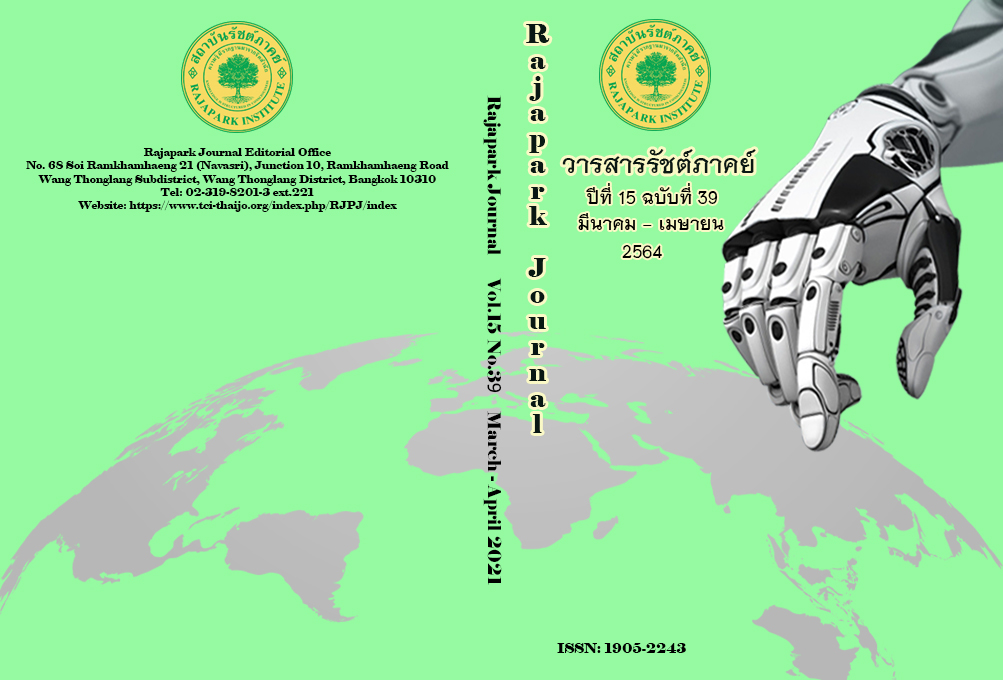A Study of Thai-English Code-Mixing and Code-Switching in GolfDigest Magazine
Main Article Content
Abstract
Linguistic phenomena of code-switching and code-mixing characterized by a particular setting have gradually been increasing throughout multicultural contexts, EFL contexts in particular. Effective communication between interlocutors in a given setting requires a mutual understanding of the conversation. This study employed the content analysis to examine the use of Thai-English code-switching and code-mixing found in 54 golf instruction articles in GolfDigest magazine. Data were analyzed based on the theoretical framework proposed by Kannaovakun and Gunther (2003), Ho (2007) for the nativized feature of code-mixing; and Poplack (1980) for code-switching. The analysis found that the occurrence of Thai-English code-mixing (ƒ = 138, 55.64%) was slightly higher than Thai-English code-switching (ƒ = 110, 44.35%). Among classification of the code-mixing, hybridization was used the most (ƒ = 32, 23.2%), followed by word order and proper noun (ƒ = 20, 14.5 %), letters of alphabets (ƒ = 17, 12.3%), truncation and conversion (ƒ=14, 10.1 %), semantic shift (ƒ = 12, 8.7%), and reduplication (ƒ = 9, 6.5%) respectively. As for the classification of Thai-English code-switching, the use of intra-sentential (ƒ = 92, 83.6%) was greater than inter-sentential (ƒ = 18, 16.4%). The results implied that a mix of two languages is commonly found when the interlocutors are to facilitate and maintain the flow of conversation and social solidarity. Importantly, it could be a useful guideline for lesson plan designs in Thailand EFL classrooms including meaning-focused as well as form-focused including realizing how the meaning of a word varies according to a particular setting.
Article Details
Views and opinions appearing in the Journal it is the responsibility of the author of the article, and does not constitute the view and responsibility of the editorial team.
References
Bernstein, E., & Herman, A. (2014). Code-Switching and Competition: An Examination of a Situational Response. Quest, 66(4), 409-420.
Clyne, M. (2003). Dynamics of Language Contact: English and Immigrant Languages. UK: Cambridge University Press.
Crystal, D. (2003). The Cambridge Encyclopedia of the English Language. UK: Cambridge University Press.
Curzan, A., & Adams, M. (2012). How English works: A linguistic introduction. Boston, USA.: Pearson Longman.
De Bot, K., Lowie, W., & Verspoor, M. (2005). Second language acquisition: An advanced resource book. New York: Routledge.
Gass, S. M., & Selinker, L. (2008). Second Language Acquisition: An Introductory Course (3rd ed.). New York: Routledge.
Giles, H., Coupland, N., & Coupland, J. (1991). Accommodation theory: Communication, context, and consequence. In H. Giles, J. Coupland, & N. Coupland (Eds.), Studies in emotion and social interaction. Contexts of accommodation: Developments in applied sociolinguistics (pp. 1–68). Cambridge, England: Cambridge University Press.
Frawley, W. J. (2003). International Encyclopedia of Linguistics (2nd ed.). Oxford, New York: Oxford University Press.
Ho, J. W. Y. (2007). Code-mixing: Linguistic form and socio-cultural meaning. The International Journal of Language Society and Culture, 21, 23-30.
Janhom, W. (2011). English-Thai Code-Mixing in Thai Health Magazine. Master of Arts. Business English for International Communication, Srinakharinwirot University.
Ju, Y. (2009). Code-mixing among Hong Kong trilingual teenagers. Master’s Dissertation. School of Arts in Linguistics, The Chinese University of Hong Kong.
Kannaovakun, P., & Gunther, A. C. (2003). The Mixing of English and Thai in Thai Television Program. Manusya: Journal of Humanities. 6, 66-80.
Likhitphongsathorn, T., & Sappapan, P. (2014). Study of English Code-Mixing and Code-switching in Thai Pop songs. Retrieved from http://www.litu.tu.ac.th/journal/FLLTCP/Proceeding/494.pdf.
Macaro, E. (2001). Analysing Student Teachers’ Codeswitching in Foreign Language Classrooms: Theories and Decision Making. The Modern Language Journal, 85(4), 531–548.
Papijit, W. (2013). Thai-English code-mixing in Hormones the series. Master of Arts. English for Professional Development, National Institute of Development Administration.
Poplack, S. (1980). Sometimes I'll start a sentence in Spanish Y Termino En Espanol: Toward a typology of code-switching. Linguistics, 18(7/8), 581-618.
Ritchie, W. C., & Bhatia, T. K. (2009). The New Handbook of Second Language Acquisition. The United Kingdom: Emerald Group Publishing.
Schneider, E. W. (2011). English Around the World: An Introduction. UK: Cambridge University Press.
Sridhar, S. N., & Sridhar, K. K. (1980). The syntax and psycholinguistics of bilingual code mixing. Canadian Journal of Psychology/Revue Canadienne de psychologies, 34(4), 407–416.
Stockwell, P. (1999). Language and linguistics, the key concepts. New York: Routledge.
Strazny, P. (2005). Encyclopedia of Linguistics. New York: Fitzroy Dearborn.
Waris, A. M. (2012). Code-switching and mixing (Communication in learning language). Journal Dakwah Tabligh, 13(1), 123–135.
Walwadkar, S. B., & Shinde, J. A. (2013). Code mixing and code switching in Indian English speech: An ICE (International corpus of English) study. Doctor of Philosophy in English. The Faculty of Arts and Fine Arts. Shivaji University, Kolhapur.


